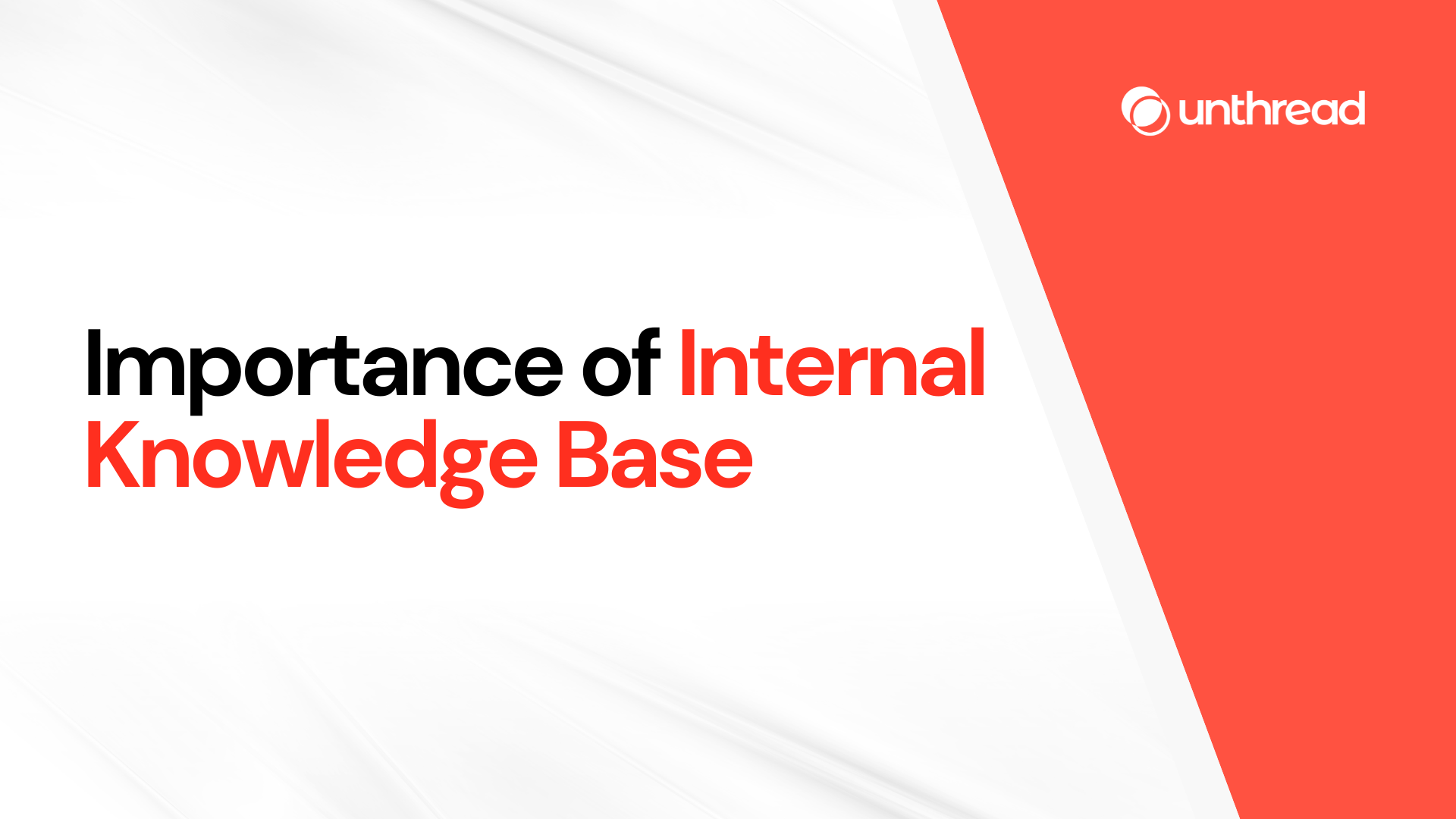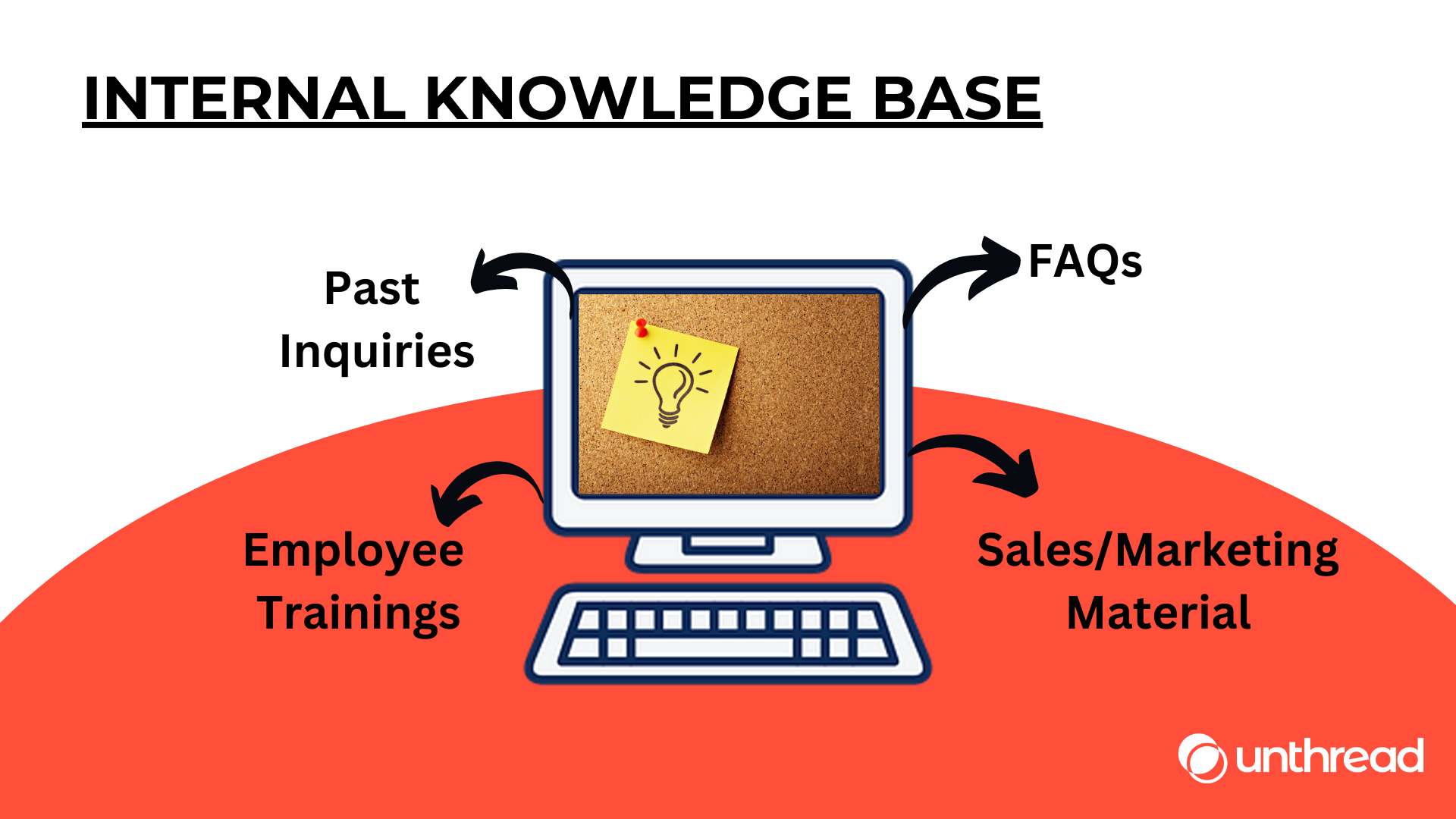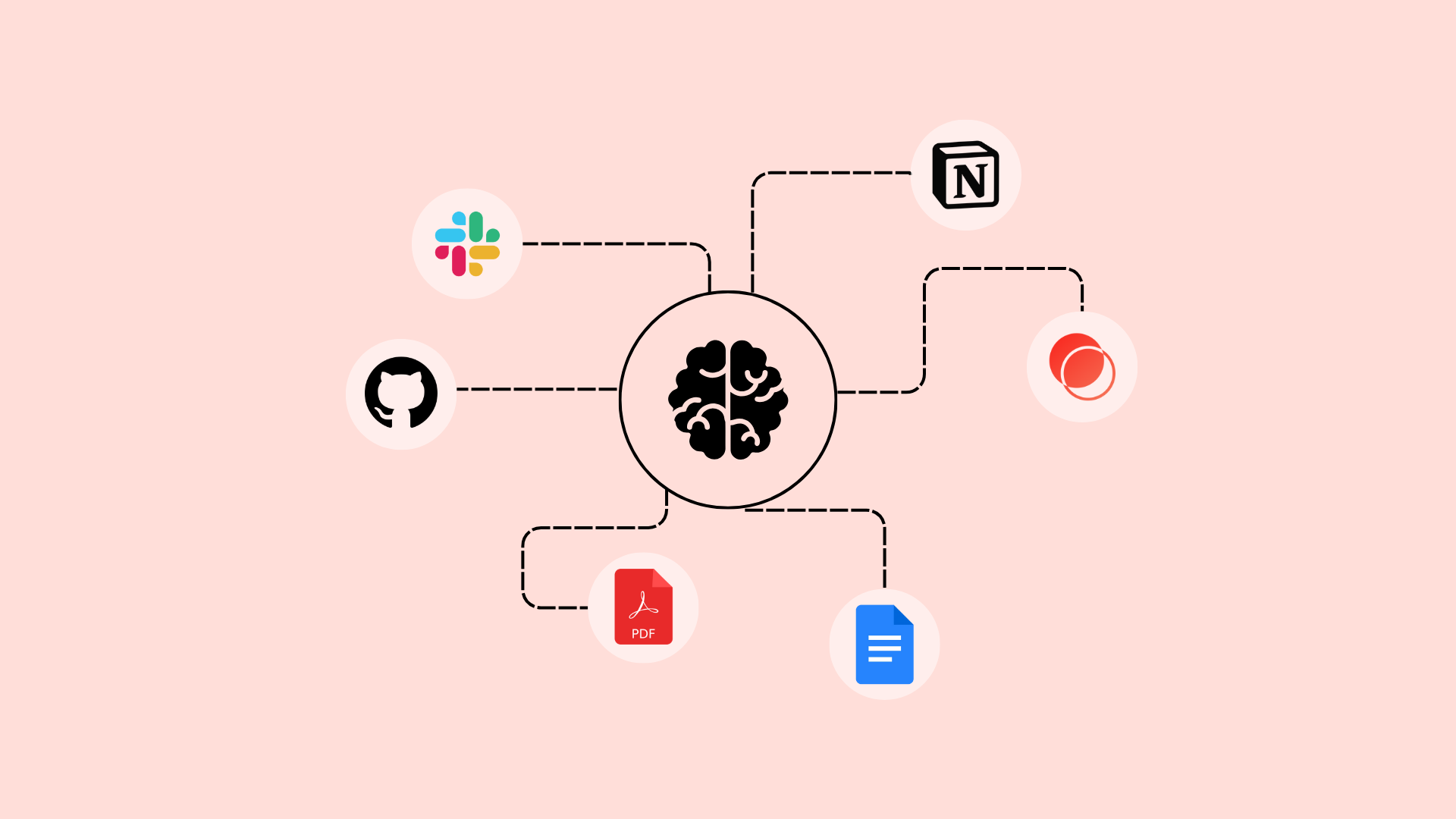What is an Internal Knowledge Base?

An internal knowledge base (or internal kb) is a centralized repository where companies store valuable knowledge and references when they need access to information. It's essentially a digital library that employees refer to access relevant information and resolve issues instantly.
An internal company knowledge base is focused on internal information. It helps employees access resources needed to do their jobs efficiently. The internal knowledge base is the single source of truth for all company knowledge, eliminating employees needing to search through scattered files or ask internal support teams for help. This makes processes faster and more efficient.
The best internal knowledge base software is built to meet every department's specific needs. It allows employees to collaborate, share knowledge assets, and ensure smooth information flow across the organization. A well-organized company knowledge base supports internal knowledge management and knowledge retention, which are crucial to helping a business grow and scale effectively.
What should be included in a company knowledge base?

Some core information needs to be addressed in a company knowledge base; however, what you add on top of that information depends on your judgment. Common materials include:
- Company Materials: Employee handbook, onboarding documentation, company policies, how-to guides, training material
- Sales and Marketing Materials: Legal documents, brand guidelines, release forms, content creation
- Security Information: SOC II compliance, GDPR, HIPAA, audit reports,
- Product Information: Product roadmap, datasheets, release notes, technical documentation, case studies
- FAQs: New hire questions, best practices, onboarding questions, product questions, customer experience,
Why Companies Need an Internal Knowledge Base for Support
Maintaining effective internal support is essential for any company, and an internal knowledge base tool is the foundation of this support system. When employees fail to complete a task, it offers fast access to the resources and information they need to continue their operations. Without a well-structured internal knowledge base, employees often have to create support tickets for repetitive tasks to IT or other support teams, which overwhelms internal teams.
An internal kb reduces this workload by providing self-service solutions. Instead of submitting tickets for repetitive tasks or minor issues, employees can find answers directly within the knowledge base. This system minimizes unnecessary interactions with support teams, allowing them to focus on more complex problems while improving overall employee satisfaction by making everyday tasks more convenient.
An internal knowledge base also provides a more structured platform for new hires. New hires can quickly access important documents like onboarding materials, training guides, and company policies, helping them get up to speed faster. This improves their onboarding experience, giving them the tools to become productive sooner.
What are the benefits of an internal knowledge base for support teams?
Setting up an internal knowledge base has many advantages. In fact, as companies scale, the benefits of a knowledge base compound. However, it's challenging to manage internal support as a large enterprise. An internal knowledge base is crucial in scaling these support operations without increasing the burden on support teams. By acting as a self-service knowledge base, it enriches the capabilities of other departments to find answers independently, reducing their reliance on support teams for every issue.
A key advantage of an internal knowledge base is its ability to grow with the company. Instead of hiring more support staff, businesses can invest in an internal wiki. As the business scales and faces new challenges, the knowledge base can expand by adding new information, solutions, and updates.
Many companies adopt a modern approach by integrating their knowledge base with ticketing systems like Unthread real-time to ensure their internal wikis are always up-to-date. When a new internal ticket is created, Unthread's AI instantly searches the company's internal kb to check if the solution exists. The ticket is automatically resolved without human intervention if it finds a match. In cases where a human agent does handle the ticket, Unthread's AI analyzes the conversation and the steps taken to resolve the issue. It then suggests a new knowledge base article based on this interaction, ensuring the company knowledge base evolves with every new inquiry and continually improves for future use.
With an auto-updated internal knowledge base, support teams can have a single source of truth, enabling team members to access verified and up-to-date product knowledge in real time. A unicorn Unthread customer recently reported saving almost $200k by adopting an internal knowledge base and Unthread combination.
Key Features of the Best Internal Knowledge Base Tools for Scaling
Not all knowledge bases are created equal, especially when supporting a company's growth. As businesses expand, the knowledge base must include critical features to handle increased demand and provide adequate support. The most important features an internal kb should have:
- AI search: AI enhances traditional search capabilities by understanding the context and intent behind user queries, offering more precise and relevant results. It can also provide summaries and recommend additional resources, helping users find comprehensive answers faster.
- AI Agents: Chatbots interact with users to better understand their questions and provide assistance based on the knowledge base. They use NLP models and machine learning to understand the user queries and effectively semantically search them in the internal database.
- Security: Adopt least privilege principles to ensure that not everybody can access all information. Additionally, safeguard the knowledge base from unauthorized access, data breaches, and cyber threats.
- Employee portal: A centralized hub that gives employees access to the knowledge base, company resources, tools, and communication channels, making it easier for them to stay connected and informed.
- Collaboration and Content Ownership: Allows different departments to contribute to the knowledge base, updating stakeholders with real-time content. Transparent document collaboration and version control ensure reliability.
How to Implement an Effective Internal Knowledge Base
Implementing an internal command base that supports growth requires careful planning, continuous updates, and proper management. Here's how to implement a knowledge base that can scale with your company:
Integrating with Existing Support Systems
Integrate your knowledge base with your existing support systems to maximize its value. Connecting your knowledge base with ticketing systems like Unthread or document management platforms like Google Docs allows automatic updates based on frequently asked questions or real-world use cases. This integration ensures that the knowledge base remains updated with the latest solutions, making it a more valuable resource for employees.

Leverage AI for content, search, and research
AI is powerful in determining knowledge base articles that address users' specific needs. Third-party tools like Unthread AI can also identify ticket gaps and suggest new articles that align with that inquiry. By writing the content for the company, tailored from a specific pain point, AI can help keep your knowledge base structured and neat.
Regular Content Updates and Maintenance
As your company grows, the information in your knowledge base must evolve. Regular updates and maintenance are necessary to ensure the content remains accurate and relevant. Assigning dedicated content owners responsible for specific tasks ensures that the knowledge base is regularly reviewed and updated. This keeps the information accurate and up to date, preventing the knowledge loss that occurs when outdated content is left in place.
Structure Content for Organization and Scalability
The first step in building an internal knowledge base solution is planning for scalability. Your knowledge base must be able to grow as your company expands. Developing a flexible content structure with proper tagging, categorization, and advanced search functions is necessary. There are two distinct ways companies can implement an effective structure to their knowledge base:
Structure by department
As the most common users, support teams, customer service, HR, and IT usually have their information separated to make the information more accessible.
Structure by role
What a new hire of an entry-level position requires will differ from that of a Director of Engineering. Associating unique reference numbers with content can be beneficial in catering to different needs.
Common Challenges in Maintaining an Internal Knowledge Base
Even a well-built internal knowledge base faces challenges over time. As a company grows, keeping the information accurate, consistent, and accessible can become more complex. Here are some common challenges and ways to overcome them:
Knowledge Loss and Outdated Information
One of the biggest challenges is keeping the information in the knowledge base current. As internal processes change and new policies are implemented, old content can become outdated, leading to confusion and inefficiencies. To prevent this, establish a system for regular reviews and updates. Assigning content owners to check for outdated information regularly ensures that the knowledge base remains relevant.
Ensuring Content Consistency
With multiple contributors updating the knowledge base, maintaining consistency in language, structure, and tone can be difficult. Inconsistent information can confuse employees and reduce their trust in the system. To maintain consistency, implement clear content guidelines that all contributors must follow. This ensures that the knowledge base remains easy to navigate and reliable.
Overcoming Low User Adoption
Another challenge is getting employees to use the knowledge base regularly, especially if it's difficult to navigate. Employees who find the knowledge base hard to use may ask colleagues for help or submit support tickets. Improving user adoption involves creating an easy-to-use option for employees. This includes a solid search function, clear categories, and intuitive navigation. Training and promoting the knowledge base through internal communication can encourage employees to use it.
External Knowledge Bases vs. Internal Knowledge Bases for Support
Internal and external knowledge bases are essential to a company's overall knowledge management strategy but serve different purposes.
Internal Knowledge Bases for Employee Support
An internal knowledge base is specifically designed to support employees. It includes training materials, company policies, troubleshooting guides, and FAQs. These tools help employees find answers quickly, reducing the need for support tickets. By providing a self-service option, an internal knowledge base helps improve employee productivity and satisfaction.
External Knowledge Bases for Customer Support
An external knowledge base is designed for customers. It includes self-service resources like product guides, troubleshooting tips, and FAQs. These systems are typically integrated with customer support teams to help customers solve their problems without contacting a support agent. By reducing the number of support requests, external knowledge bases improve customer satisfaction and make customer service teams more efficient.
Unthread's Position As an ITSM Platform for Knowledge Base
What is Unthread?
Unthread is an AI-powered ITSM platform that tracks and resolves tickets instantly from Slack. We automatically track tickets from Slack threads and use AI to categorize, escalate, and run workflows to solve issues before they reach a human agent.
How Does Unthread Help Internal Knowledge Bases?
An enterprise company creates 400+ tickets for its support teams. Unthread, the center of this communication network, is very connected to knowledge bases. When a user generates a ticket for IT, HR, RevOps, or the PeopleOps team, Unthread's AI instantly searches the company's knowledge base system for relevant information. When Unthread's AI cannot resolve a ticket due to missing information, the AI starts to track the conversation and the steps the support agent takes to resolve the issue. The AI learns from the conversation by teaching and replicating these steps and suggests a new knowledge base article based on this interaction. By doing so, Unthread plays a crucial role in evolving companies' internal knowledge bases.
Does Unthread Has Its Knowledge Base?
Unthread offers multiple options for its customers. The tool integrates well with other solutions. For customers who'd like to host their internal wikis on Unthread, there is also a built-in knowledge base system in the enterprise plan.
Conclusion
An internal knowledge base tool is an essential tool for any growing company. It acts as a centralized repository for critical documents, policies, and procedures, making it easier for employees to access the necessary information. Self-service solutions. To ensure the knowledge base tools remain effective, they must be regularly updated, integrated with other support systems, and designed with scalability. Despite the challenges of maintaining accuracy and consistency and ensuring user adoption, a well-maintained internal knowledge base is one of the most valuable assets a company can have.
As businesses grow, the need for both internal and external knowledge bases will increase. These systems create a more efficient and productive workplace by offering employees and customers easy access to information. An internal knowledge base helps scale internal operations and boosts overall employee satisfaction by giving them the tools they need to succeed. Similarly, external knowledge bases improve customer satisfaction by empowering customers to solve their problems without relying heavily on customer support teams.
Ultimately, a tremendous internal knowledge base is more than a document storage space. It becomes a key driver of business growth, employee engagement, and operational efficiency. By implementing the right knowledge management tools, businesses can ensure their internal knowledge base evolves with them, delivering long-term value and support.

